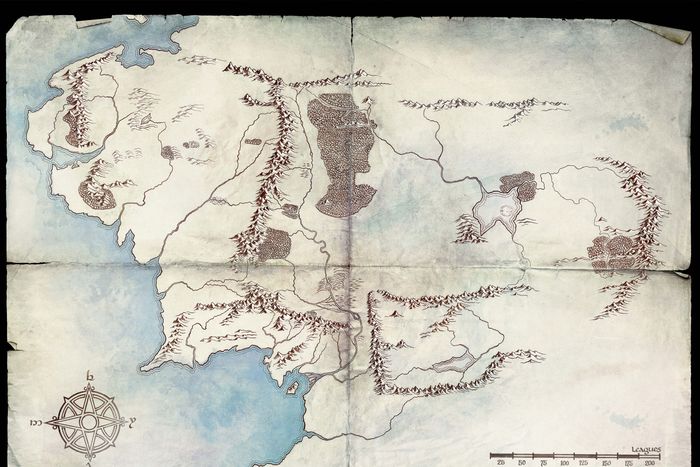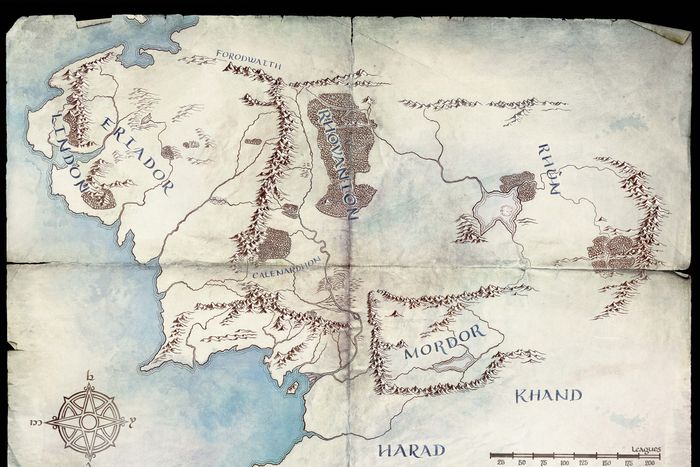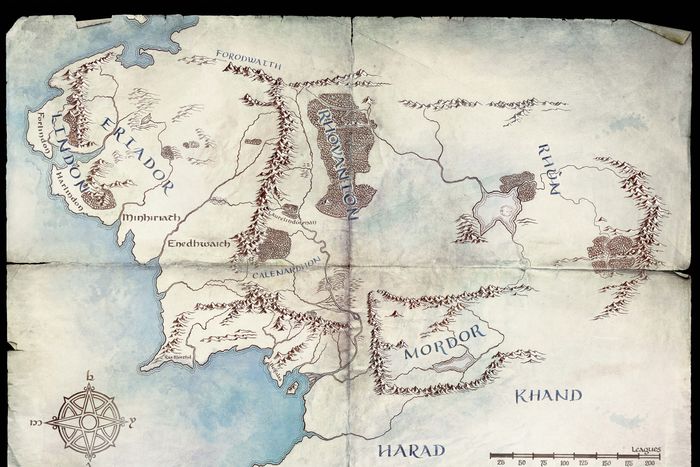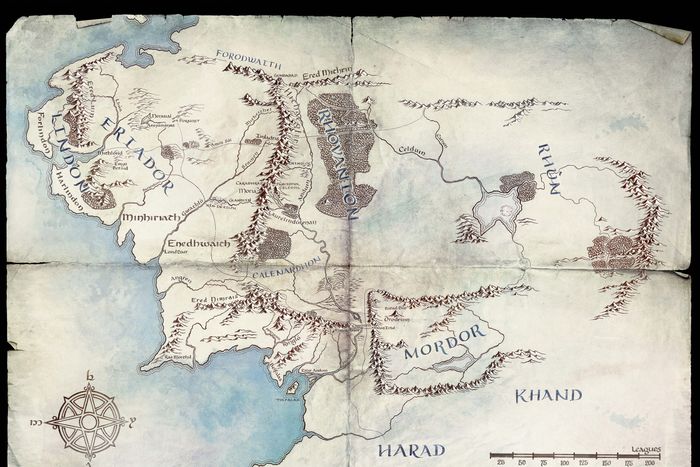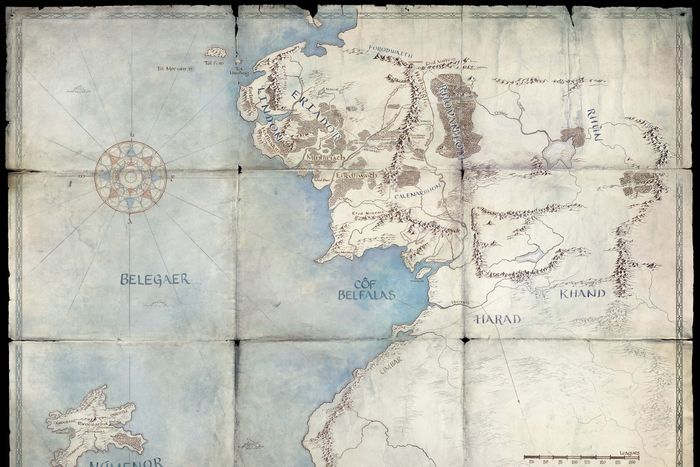
“I wisely started with a map,” J.R.R. Tolkien once said of his fictional world, and now so has Amazon Prime Video, which paid a reported $250 million for the rights to produce a Lord of the Rings TV series. Early rumors suggested a Young Aragorn show. But the five maps of Middle-earth that Amazon released earlier this month tell a different story — or rather, stories.
The five maps move backward through Middle-earth history, illustrating a long stretch of time that runs from 5,000 to 500 years before Frodo and the Fellowship began their journey in The Lord of the Rings. For casual fans who may not be familiar with Tolkien’s detailed record of each era, not to mention the heroes and villains who occupied them, the trove of clues about the upcoming show aren’t immediately obvious. But for those curious enough to do some digging, the maps reveal the show’s potential narrative aims. Let’s take a look at each one and their most significant details.
Map No. 1: The Third Age of Middle-earth
The first map only shows us the land, with nary a river or mountain labeled. But even without any place names, we know this map depicts the Third Age, a.k.a. the Age of Men that began with the first defeat of Sauron. See the big bite taken out of Mirkwood forest in the center? The Northmen carved out Mirkwood’s East Bight in the Third Age. And it’s not the first forest Men have drastically changed, as we’ll see.
Map No. 2: Even Old Rohan Was Once Calenardhon
The second map adds regional names, and one of those names — Calenardhon, seen in the center-left — seems to quash the idea that the show will focus on Aragorn. Imagine looking at a map of North America and seeing New York City labeled as New Amsterdam: You’d know immediately it was an old map. Calenardhon eventually gets settled by the Eorlingas and is renamed Rohan, home of everyone’s favorite blonde Ringwraith-slayer Éowyn. But Rohan was established around 500 years before The Lord of the Rings takes place. Aragorn is old, but he’s not that old.
Map No. 3: The Rise of Sauron and the Creation of the Rings of Power
We get more names on the third map, and like Calenardhon, the most surprising one is an older name for a very familiar place: Laurelindórenan. This was the ancient name of Lothlórien, the Elven realm where Frodo and Company met Galadriel. Tolkien never settled on a specific timeline for the Lady of Lórien, but Galadriel is usually thought to have settled in Laurelindórenan/Lothlórien in the middle of the Second Age, around the time the Elven-smiths in the land of Eregion made the Rings of Power. Helping them make those Rings was a gorgeous fellow named Annatar, who turned out to be the Dark Lord Sauron in disguise. (And yes, this means we might get a Hot Sauron.) Long story short, Sauron made the One Ring to control the others, sacked Eregion, and managed to seize most of the Rings. He gave seven to the dwarves, which intensified their lust for precious metals. He gave nine to Men, who slowly decayed into the undead Ringwraiths. But he never found the three Elven rings — one of which Galadriel took with her when she fled Eregion to Laurelindórenan.
Map No. 4: The Golden Age of Gondor
The second to last map features an explosion of place names, and looks to be a map from earlier in the Third Age, when the kingdoms of Men, Gondor, and Arnor were at the height of their power. In the bottom-center of the map, right next door to Mordor, are familiar locations with unfamiliar names: Gondor’s cities of Minas Ithil and Minas Anor. Around a thousand years before Frodo set off to return some bad jewelry, the city of Minas Ithil (translation: Tower of the Moon) was conquered by the Ringwraiths and given the extremely metal name Minas Morgul (Tower of Black Sorcery). Its sister-city Minas Anor (Tower of the Sun), not one to be shown up, changed its name to Minas Tirith (Tower of Guard). Minas Tirith is the capital of Gondor in Frodo’s time, that great city stacked up like a wedding cake.
Up north, there’s no Shire yet, but there is Annúminas, first capital of Gondor’s sister-kingdom of Arnor. Annúminas was abandoned when Arnor split into three squabbling kingdoms. Those kingdoms were slowly picked off and destroyed by the Witch-king of Angmar (a.k.a the Lord of the Ringwraiths) and the last remnants of their population went into the shadows and became the Rangers. And it was the dwindling population of Arnor that led one of its later kings to freely grant a big chunk of real estate to a group of short hairy people who showed up one day looking for good land to till.
Alongside the settlements of Men, we can see Elrond’s homely house of Imladris, a.k.a. Rivendell, near the center of the map. Due south from there we see Moria, once the great dwarf city of Khazad-dûm. Moria means “Black Pit” in Elvish, and it became the common name for the place after the Dwarves mined too deeply, thanks to the influence of the ring Sauron gave them, and woke the demonic Balrog (about a millennium before Gandalf told him he shall not pass). Then again, the Dwarves carved “Moria” on the front door long before they abandoned it, so they must have liked the name, or at least had a charming sense of self-deprecation about it, like that Austrian village called Fucking.
Finally, take note of the town of Lond Daer on the coast. This was the first permanent settlement and shipbuilding center of the Númenoreans (ancestors of Gondor and Arnor) in Middle-earth.
Map No. 5: The Second Age of Middle-earth and the Legend of Númenor
And here it is! Amazon’s final map takes a giant leap backwards in time and welcomes us to the Second Age. The landscape looks very different: Mirkwood’s East Bight is gone, and there are vast forests upriver from Lond Daer. Most surprising of all, Númenor itself! The star-shaped island off the coast is Tolkien’s take on Atlantis. It was a nation of Men so wise and powerful they easily defeated Sauron–twice. But the Númenoreans became power hungry. They devastated the forests surrounding Lond Daer to build their fleets. And they began to fear death, despite having centuries-long lifespans.
The last king of Númenor, Ar-Pharazôn the Golden, seized the throne in a violent coup. He wanted to rule the world, so he sailed to Middle-earth and took Sauron captive (no mean feat when you remember Sauron was a fallen angel). Goaded on by the Dark Lord with the help of the One Ring on his finger, Ar-Pharazôn turned against the Elves and even began worshipping Sauron’s old boss, Morgoth (Tolkien’s version of Lucifer). Envious of the immortal Elves, Ar-Pharazôn and the Númenoreans created an enormous armada and sailed into the West to attack the Blessed Realm, in order to force the gods to grant them eternal life. It ended poorly: Eru, God Himself, stepped in and drowned Númenor beneath the sea, then removed the Blessed Realm from the earth, and changed earth from a disc to a globe. (When I say Men drastically change the landscape, that includes the literal shape of the planet.) The only people to escape Númenor’s destruction were Aragorn’s ancestors: the Elf-loving rebels Elendil and his followers. Elendil and his sons Isildur and Anárion founded Gondor and Arnor, helped defeat Sauron again, and took the One Ring from him. Then Isildur lost it in a river until, two millennia later, a certain hobbit named Sméagol found it and made it his precious.
So, what do these five maps tell us about Amazon’s series?
First, that showrunners JD Payne and Patrick McKay are likely interested in telling stories across a vast swath of Middle-earth’s ages, connected by the history of the 20 Rings of Power, much as the Silmaril jewels connect the various stories of the First Age in Tolkien’s The Silmarillion. The attention to deforestation on the map also suggests they’ve a keen understanding of Tolkien’s themes of environmental devastation and the hubris of Men.
Second, that Amazon is almost certainly hoping to capitalize on the popularity of Game of Thrones with this show. Tolkien only sketched out the creation of the Rings of Power and the Fall of Númenor, but those are stories rife with the sort of political intrigue, epic battles, sexy villains, magic, and looming catastrophe that have become popular in fantasy prestige TV. Whatever the Lord of the Rings series turns out to be, it appears Amazon wants to bring many different stories from Middle-earth’s history, and in the darkness bind them.


